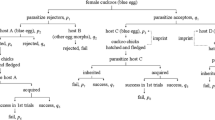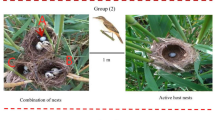Abstract
Reproductive success of brood parasites largely depends on appropriate host selection and, although the use of inadvertent social information emitted by hosts may be of selective advantage for cuckoos, this possibility has rarely been experimentally tested. Here, we manipulated nest size and clutch colouration of magpies (Pica pica), the main host of great spotted cuckoos (Clamator glandarius). These phenotypic traits may potentially reveal information about magpie territory and/or parental quality and could hence influence the cuckoo’s choice of host nests. Experimentally reduced magpie nests suffered higher predation rate, and prevalence of cuckoo parasitism was higher in magpie nests with the densest roofs, which suggests a direct advantage for great spotted cuckoos choosing this type of magpie nest. Colouration of magpie clutches was manipulated by adding one artificial egg (blue or cream colouration) at the beginning of the egg-laying period. We found that host nests holding an experimental cream egg experienced a higher prevalence of cuckoo parasitism than those holding a blue-coloured egg. Results from these two experiments suggest that great spotted cuckoos cue on magpie nest characteristics and the appearance of eggs to decide parasitism, and confirm, for the first time, the ability of cuckoos to distinguish between eggs of different colours within the nest of their hosts. Several hypothetical scenarios explaining these results are discussed.





Similar content being viewed by others
References
Álvarez F (1993) Proximity of trees facilitates parasitism by cuckoos Cuculus canorus on rufous warblers Cercotrichas galactotes. Ibis 135:331
Avilés JM, Soler JJ, Soler M, Møller AP (2004) Egg appearance and rejection behaviour in magpies. Anim Behav 67:951–958
Antonov A, Stokke BG, Moksnes A, Røskaft E (2007) Factors influencing the risk of common cuckoo Cuculus canorus parasitism on marsh warblers Acrocephalus palustris. J Avian Biol 38:390–393
Avilés JM, Stokke BG, Moksnes A, Røskaft E, Asmul M, Møller AP (2006a) Rapid increase in cuckoo egg matching in a recently parasitized reed warbler population. J Evol Biol 19:1901–1910
Avilés JM, Stokke BG, Parejo D (2006b) Relationship between nest predation suffered by hosts and brown-headed cowbird parasitism: a comparative study. Evol Ecol 20:97–111
Avilés JM, Moskat C, Ban M, Hargitai R, Parejo D (2009) Common cuckoos (Cuculus canorus) do not rely on indicators of parental abilities when searching for host nests: the importance of host defenses. Auk 126:431–438
Baeyens G (1981) Magpie breeding success and Carrion Crow interference. Ardea 69:125–139
Begum S, Moksnes A, Røskaft E, Stokke BG (2011a) Factors influencing host nest use by the brood parasitic Asian Koel (Eudynamys scolopacea). J Ornithol 152:793–800
Begum S, Moksnes A, Røskaft E, Stokke BG (2011b) Interactions between the Asian koel (Eudynamys scolopacea) and its hosts. Behaviour 148:325–340
Birkhead TR (1991) The magpies. The ecology and behaviour of black-billed and yellow-billed magpies. Poyser, London
Brooker LC, Brooker MG, Brooker AMH (1990) An alternative population/genetic model for the evolution of egg mimesis and egg cripsis in cuckoos. J Theor Biol 146:123–143
Cherry MI, Bennett ATD, Moskat C (2007) Do cuckoos choose nests of great reed warblers on the basis of host egg appearance? J Evol Biol 20:1218–1222
Danchin E, Giraldeau LA, Valone TJ, Wagner RH (2004) Public information: from nosy neighbours to cultural evolution. Science 305:487–491
De Neve L, Soler JJ (2002) Nest-building activity and laying date influence female reproductive investment in magpies: an experimental study. Anim Behav 63:975–980
De Neve L, Soler JJ, Soler M, Pérez-Contreras T (2004) Nest size predicts the effect of food supplementation to magpie nestlings on their immunocompetence: an experimental test of nest size indicating parental ability. Behav Ecol 15:1031–1036
English PA, Montgomerie R (2011) Robin’s egg blue: does egg color influence male parental care? Behav Ecol Sociobiol 65:1029–1036
Grim T, Samas P, Moskat C, Kleven O, Honza M, Moksnes A, Røskaft E, Stokke BG (2011) Constraints on host choice: why do parasitic birds rarely exploit some common potential hosts? J Anim Ecol 80:508–518
Hanley D, Doucet SM (2009) Egg coloration in ring-billed gulls (Larus delawarensis): a test of the sexual signaling hypothesis. Behav Ecol Sociobiol 63:719–729
Hanley D, Cassey P, Doucet SM (2013) Parents, predators, parasites, and the evolution of eggshell colour in open nesting birds. Evol Ecol 27:593–617
Hansell M (2000) Bird nests and construction behaviour. Cambridge University Press, Cambridge
Honza M, Procházka P, Stokke BG, Moksnes A, Røskaft E, Capek M, Mrlik V (2004) Are blackcaps current winners in the evolutionary struggle against the common cuckoo? J Ethol 22:175–180
Honza M, Pozgayová M, Procházka P, Cherry M (2011) Blue–green eggshell coloration is not a sexually selected signal of female quality in an open-nesting polygynous passerine. Naturwissenschaften 98:493–499
Hoover JP, Robinson SK (2007) Retaliatory mafia behavior by a parasitic cowbird favors host acceptance of parasitic eggs. Proc Natl Acad Sci USA 104:4479–4483
Krist M, Grim T (2007) Are blue eggs a sexually selected signal of female collared flycatchers? A cross-fostering experiment. Behav Ecol Sociobiol 61:863–876
Langmore NE, Hunt S, Kilner RM (2003) Escalation of a coevolutionary arms race through host rejection of brood parasitic young. Nature 422:157–160
Martín-Gálvez D, Soler JJ, Martínez JG, Krupa AP, Soler M, Burke T (2007) Cuckoo parasitism and productivity in different magpie subpopulations predict frequencies of the 457 bp allele: a mosaic of coevolution at a small geographic scale. Evolution 61:2340–2348
Martín-Vivaldi M, Soler JJ, Møller AP, Pérez-Contreras T, Soler M (2012) The importance of nest-site and habitat in egg recognition ability of potential hosts of the Common Cuckoo Cuculus canorus. Ibis 155:140–155
Moksnes A, Røskaft E (1995) Egg-morphs and host preferences in the common cuckoo (Cuculus canorus): an analysis of cuckoo and host eggs from European museum collections. J Zool Lond 236:625–648
Molina-Morales M, Martínez JG, Martín-Gálvez D, Dawson A, Rodríguez-Ruiz J, Burke T, Avilés JM (2012) Evidence of long-term structured cuckoo parasitism on individual magpie hosts. J Anim Ecol 82:389–398
Moreno J, Osorno JL (2003) Avian egg colour and sexual selection: does eggshell pigmentation reflect female condition and genetic quality? Ecol Lett 6:803–806
Moreno J, Soler M, Møller AP, Linden M (1994) The function of stone carrying in the black wheatear, Oenanthe leucura. Anim Behav 47:1297–1309
Moreno J, Lobato E, Merino S, Martinez-de La Puente J (2008) Blue-green eggs in pied flycatchers: an experimental demonstration that a supernormal stimulus elicits improved nestling condition. Ethology 114:1078–1083
Ortega CP, Ortega JC, Cruz A (1994) Use of artificial brown-headed cowbird eggs as a potential management tool in deterring parasitism. J Wildl Manag 58:488–492
Palomino JJ, Martín-Vivaldi M, Soler M, Soler JJ (1998) Functional significance of nest size variation in the Rufous Bush Robin Cercotrichas galactotes. Ardea 86:177–185
Parejo D, Avilés JM (2007) Do avian brood parasites eavesdrop on heterospecific sexual signals revealing host quality? A review of the evidence. Anim Cogn 10:81–88
Polacikova L, Procházka P, Cherry MI, Honza M (2009) Choosing suitable hosts: common cuckoos Cuculus canorus parasitize great reed warblers Acrocephalus arundinaceus of high quality. Evol Ecol 23:879–891
Procházka P, Honza M (2003) Do Common Whitethroats (Sylvia communis) discriminate against alien eggs? J Ornithol 144:354–363
Quesada J (2007) The different roles of the roof density and nest size in the Iberian magpie nest. Acta Ethol 10:41–45
Quinn GP, Keough MJ (2002) Experimental design and data analysis for biologists. Cambridge University Press, Cambridge
Reynolds SJ, Martin GR, Cassey P (2009) Is sexual selection blurring the functional significance of eggshell coloration hypotheses? Anim Behav 78:209–215
Røskaft E, Moksnes A, Stokke BG, Moskat C, Honza M (2002) The spatial habitat structure of host populations explains the pattern of rejection behavior in hosts and parasitic adaptations in cuckoos. Behav Ecol 13:163–168
Sanz JJ, Garcia-Navas V (2009) Eggshell pigmentation pattern in relation to breeding performance of blue tits Cyanistes caeruleus. J Anim Ecol 78:31–41
Sanz JJ, García-Navas V (2011) Nest ornamentation in blue tits: is feather carrying ability a male status signal? Behav Ecol 22:240–247
Sato NJ, Tokue K, Noske RA, Mikami OK, Ueda K (2010) Evicting cuckoo nestlings from the nest: a new anti-parasitism behaviour. Biol Lett 6:67–69
Soler M (1990) Relationships between the great spotted cuckoo Clamator glandarius and its corvid hosts in a recently colony area. Ornis Scand 21:212–223
Soler M, De Neve L (2013) Brood mate eviction or brood mate acceptance by brood parasitic nestlings? An experimental study with the non-evictor great spotted cuckoo and its magpie host. Behav Ecol Sociobiol 67:601–607
Soler JJ, Soler M (2000) Brood-parasite interactions between great spotted cuckoos and magpies: a model system for studying coevolutionary relationships. Oecologia 125:309–320
Soler JJ, Soler M, Møller AP, Martínez JG (1995a) Does the great spotted cuckoo choose magpie hosts according to their parenting ability? Behav Ecol Sociobiol 36:201–206
Soler M, Martínez JG, Soler JJ, Møller AP (1995b) Preferential allocation of food by magpie Pica pica to great spotted cuckoo Clamator glandarius chicks. Behav Ecol Sociobiol 37:7–13
Soler M, Soler JJ, Martínez JG, Møller AP (1995c) Magpie host manipulation by great spotted cuckoos: evidences for an avian mafia? Evolution 49:770–775
Soler M, Soler JJ, Møller AP, Moreno J, Linden M (1996) The functional significance of sexual display: stone carrying in the black wheatear. Anim Behav 51:247–254
Soler JJ, Cuervo JJ, Møller AP, de Lope F (1998a) Nest building is a sexually selected behaviour in the barn swallow. Anim Behav 56:1435–1442
Soler JJ, Møller AP, Soler M (1998b) Nest building, sexual selection and parental investment. Evol Ecol 12:427–441
Soler M, Soler JJ, Martínez JG (1998c) Duration of sympatry and coevolution between the great spotted cuckoo (Clamator glandarius) and its primary host, the magpie (Pica pica). In: Rothstein SI, Robinson SK (eds) Parasitic birds and their hosts, studies in coevolution. Oxford University Press, Oxford, pp 113–128
Soler JJ, De Neve L, Martínez JG, Soler M (2001) Nest size affects clutch size and the start of incubation in magpies: an experimental study. Behav Ecol 12:301–307
Soler JJ, Moreno J, Avilés JM, Møller AP (2005) Blue and green egg-color intensity is associated with parental effort and mating system in passerines: support for the sexual selection hypothesis. Evolution 59:636–644
Soler JJ, Navarro C, Pérez-Contreras T, Avilés JM, Cuervo JJ (2008) Sexually selected egg coloration in spotless starlings. Am Nat 171:183–194
Soler JJ, Avilés JM, Møller AP, Moreno J (2012) Attractive blue–green egg coloration and cuckoo-host coevolution. Biol J Linn Soc 106:154–168
Soler JJ, Martin-Galvez D, De Neve L, Soler M (2013) Brood parasitism correlates with the strength of spatial autocorrelation of life history and defensive traits in magpies. Ecology 94:1338–1346
Spottiswoode CN (2013) A brood parasite selects for its own egg traits. Biol Lett 9:20130573
Statsoft Inc. (2011) STATISTICA (data analysis software system), version 10. www.statsoft.com
Szentirmai I, Komdeur J, Székely T (2005) What makes a nest-building male successful? Male behavior and female care in penduline tits. Behav Ecol 16:994–1000
Welbergen JA, Davies NB (2009) Strategic variation in mobbing as a front line of defense against brood parasitism. Curr Biol 19:235–240
White DJ, Ho L, los Santos G, Godoy I (2007) An experimental test of preferences for nest contents in an obligate brood parasite, Molothrus ater. Behav Ecol 18:922–928
Acknowledgments
Comments by two anonymous reviewers substantially contribute to improve the quality and understanding of the article. Funding was provided by the Spanish Ministerio de Educación y Ciencia and European funds (FEDER) (CGL2010-19233-C03-01 to J.J.S, CGL2008-00718 and CGL2011-27561 to J.M.A., and CGL2011-25634/BOS to M.S.), and by JAE and “Juan de la Cierva” postdoctoral Grants from the CSIC and the Spanish Ministry of Education and Science, respectively, to D.M.G. and L.D.N.. Permission for nest visits and experiments was granted by the Junta de Andalucía (Spanish Regional Government).
Author information
Authors and Affiliations
Corresponding author
Additional information
Communicated by Oliver P. Love.
Electronic supplementary material
Below is the link to the electronic supplementary material.
Rights and permissions
About this article
Cite this article
Soler, J.J., Avilés, J.M., Martín-Gálvez, D. et al. Eavesdropping cuckoos: further insights on great spotted cuckoo preference by magpie nests and egg colour. Oecologia 175, 105–115 (2014). https://doi.org/10.1007/s00442-014-2901-2
Received:
Accepted:
Published:
Issue Date:
DOI: https://doi.org/10.1007/s00442-014-2901-2




